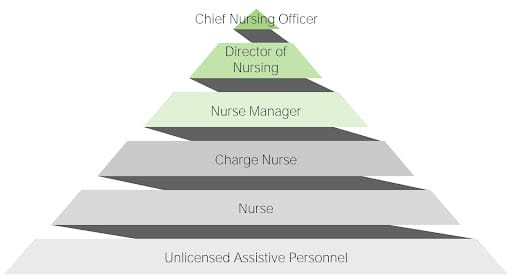What is the chain of command in nursing?
The nursing chain of command is the line of authority and responsibility along which orders are passed within the nursing department, the hospital, and between various departments.
Knowing the chain of command and using it to report things you are concerned about helps you advocate for your clients effectively, and also protects you in the case of litigation.
Common lines of authority
In the nursing hierarchy, lines of authority typically progress from frontline staff to executive leadership. The exact chain of command may vary slightly between institutions, but the general organizational chart will usually be similar. Common positions, in order of ascending authority, include:
- Unlicensed assistive personnel: UAPs, or patient care technicians: provide basic patient care
- LPNs or similar: nursing personnel working under the guidance of registered nurses
- Registered nurses (RNs)
- Charge nurse: experienced RN overseeing a shift or unit
- Nurse manager: responsible for unit of department, overseeing budget and staff
- ARPNs, NPs, clinical nurse specialists, nurse midwives, etc: Their advanced education and training results in more authority.
- Director of nursing: oversees multiple units or a facility
- Chief nursing officer: executive responsibility for nursing practices across an organization

Benefits of hierarchy in healthcare
While with hierarchies it is always important to ensure they don’t hinder open communication or become overly rigid, a clear hierarchy in healthcare is necessary and has a positive impact. The goals and benefits of a clear hierarchy in the healthcare team include:
- Efficient communication: Channels for information flow are predefined by hierarchical structure, which streamlines communication.
- Preventing overlaps and gaps in care: The healthcare hierarchy clearly defines the scope and limits of each role’s responsibilities.
- Efficient and quick decision-making: This is especially important in critical situations.
- Accountability and quality control: The clear hierarchy ensures that it is clear at all times who is responsible for what, aiding accountability and continuous improvement.
- Effective interdisciplinary collaboration: The clearly defined roles and lines of communication promotes effective teamwork even between different teams.
- Patient safety and standards: Hierarchies promote the implementation of standardized protocols which helps consistency of care, and clear reporting mechanisms in a fixed hierarchy structure allow swift intervention when needed.
Example problem: hospital chain of command
Imagine you are a new RN in a pediatric unit. A newly admitted child is having increasing difficulty breathing. You have placed several calls to the pediatrician but have not received a return call. The charge nurse for the day has left the unit for lunch and is not responding to your attempt to reach her either. Who is the next person in the chain of command that you might call?
- Unlicensed assistive personnel
- The nurse manager
- A charge nurse
- The director of nursing
- The chief nursing officer
- Another nurse
If you selected the nurse manager, that is correct. Typically, the charge nurse answers to the nurse manager – since the charge nurse is not available, the next best option is to move up one step in the chain of command: the nurse manager.
